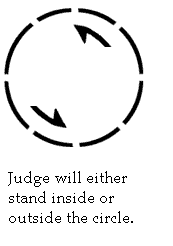|
'
Showing Your Cavalier'

Welcome to the World of Dog Showing!.....
Before your journey starts, there are a few things I
recommend. First research as much as you can on the breed, meet with
breeders (in their homes also not only at dog shows), and preferably visited a
few conformation shows. I also recommend visiting at least one or two
Cavalier Specialty Shows and if possible obtain a club yearbook (if your
state club publishes one).
Once you have adopted your first "show potential" Cavalier
from a reputable breeder, your journey begins. I do like to call
puppies show potential as the most promising puppy sometimes does not make the
grade for the conformation ring at maturity.
You will need to join you local canine controlling
body and obtain a gazette/booklet of conformation hows to be held. Before
showing you dog for the first time, visit a few shows to see what goes on in the
show ring. The dog shows are usually divided into groups, and then judged
in alphabetical order. Cavaliers for instance are usually on within the
first 15 minutes of the scheduled starting time of the show. Entries usually
close 4-5 weeks before the event (with the exception of Royals which have to be
pre-entered much earlier)
Arrive at least 1 hour before the scheduled time of
the show, this gives you adequate time to set a space up for yourself and your
dog near the ring you will be exhibiting in. You will also have time to
take your dog to the toilet, give him/her a last minute brushing, pick up a
catalogue if you have ordered one and have a relaxing coffee.
The steward will call your exhibit number (so it is
best to be prepared a few classes before hand, as I have experienced times when
a whole class before mine was absent). If is best to be at ringside, as
with 3 calls of your number you are automatically classed as being absent. It is
also best to watch the classes/breeds on before you so you can see which show
ring procedure the judge is using.
Always show your dog on your left hand side (so the
judge can get a good view of your dog).
When returning to the judge, make your dog stand in
the best position. Sometimes you may have to get the dog to take a few steps
forward after stopping.
Move the dog, as the judge requests.
Remember your dog is always on show, even if the
judge isn't looking as some will glance back to see the dog in its natural pose.
Show Ring Patterns
Judges usually do different sequences but they
usually consist of the following:
* Around the Ring
* Out and Back
* The Triangle
Around The Ring

Around the ring is one of the easiest patterns.
The ring is square
and you move the dogs
you move the dogs around in a circular
pattern.
After doing the circular pattern
you will stop where the judge has requested.
In larger classes the judge may ask you to
go around the ring twice. With
this ring
pattern the judge can see the movement of
your dog, his/her
topline and how they
move compared to the rest of the class.
Leave a small
distance between you and the
dog in front.
.
|

Out and Back
You will move your dog away from the
judge,
then with a smooth curve make your
way back. This pattern is so the
judge can
see the dog on the move coming and going.
In this procedure the
judge can see various
things as an example, on the way out he can
view
the the position of the
hocks when on
the move.
|

The Triangle
In this procedure you move the dog away
from the
judge. This gives the judge a clear
view of the dogs rear straight on.
It is best
to move out further distance than out and
back. Then as you
turn across the ring, this is
showing the judge the dogs movement from
the
side. On coming back to the judge, he
is looking at the movement
of the dog
coming towards him.
|
Won Your Class, What Happens Now?


Music:
You Ain't Seen Nothing Yet - Bachman-Turner Overdrive
© Braydnvale Cavaliers 2004

|